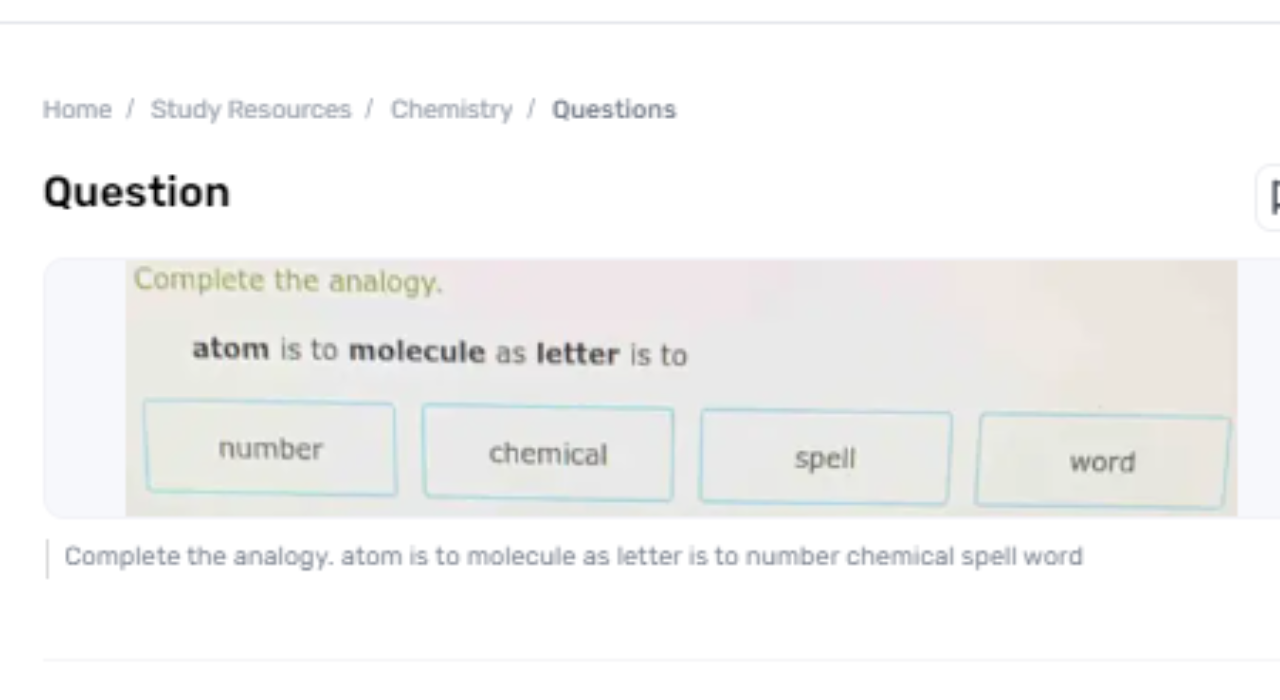Analogies are capable instruments in dialect and thinking, permitting us to make complex connections by comparing them to less complex or more recognizable concepts. In analogical thinking, the relationship between sets of words or concepts can offer assistance clarify how diverse components relate to one another. The relationship “atom is to molecule as letter is to” prompts us to investigate the relationship between letters and the structures they frame, compared to how iotas combine to make atoms. This exposition will dismember this similarity, clarifying the associations between iotas and atoms, letters and words, and how these connections offer assistance light up the structure and composition of dialect.
Understanding the Atom-Molecule Relationship
To completely get a handle on the similarity, it is basic to get the relationship between atoms and atoms. Molecules are the essential building pieces of matter, each comprising of a nucleus encompassed by electrons. They combine through chemical bonds to create atoms, which are bunches of iotas held together by these bonds. Particles can be basic, like oxygen (O), or complex, like DNA.
The Part of Letters in Language
In a parallel way, letters are principal units of written language. They speak to person sounds and are combined to make words, sentences, and whole writings. Fair as molecules combine to form particles, letters combine to make significant units of dialect. Each letter has its claim characteristics, but when organized in particular arrangements, they shape words, which are the building pieces of composed communication. The combination of letters into words is basic for passing on thoughts, feelings, and data in the composed frame.
Letter to Word Relationship
The relationship “iota is to particle as letter is to” can be completed by understanding that the relationship between letters and words mirrors that of molecules and particles. In this relationship, letters are to words as iotas are to particles. Fair as molecules combine to create atoms, letters combine to make words. Words, like particles, are more complex and carry meaning derived from the combination of their constituent letters. This relationship highlights how smaller units (letters or iotas) come together to make bigger, more complex structures (words or atoms) that serve a more prominent work.
The Method of Arrangement
The method of combining letters to create words can be compared to the chemical handle of shaping particles from molecules. In chemistry, particles are associated with creating particles through chemical bonds, coming about in modern substances with diverse properties from the personal particles. Additionally, in dialect, letters are combined concurring with syntactic rules and traditions to create words, that carry meaning and contribute to viable communication. This preparation of combination and arrangement outlines how principal units can make complex and useful structures in both science and dialect.
The Significance of Analogical Thinking
Analogies, such as “iota is to atom as letters to a word,” serve as important apparatuses for understanding connections and forms. By comparing the arrangement of particles from molecules to the creation of words from letters, we pick up an understanding of the nature of structure and complexity in numerous settings. Analogical thinking makes a difference in clarifying unique concepts and uncovering basic designs and associations. It too illustrates the inclusiveness of certain standards, such as the thought that smaller units combine to form larger, more complex substances with particular capacities and properties.
Approach for Replying to a Gauth Request
1. Identify the Query’s Center:
Decide on the off chance that the address is related to setup, utilization, administration, or investigation to outline your reaction viably.
2. Obtain Important Subtle elements:
Survey official Gauth materials and consider ordinary client challenges to guarantee a well-rounded and accurate answer.
3. Draft the Reply:
Organize the data in a clear, step-by-step organize, specifically tending to the components of the address.
4. Confirm and Refine:
Confirm the rightness of your reaction and refine it for clarity, guaranteeing it is brief and effectively reasonable.

Conclusion
In conclusion, the relationship “molecule is to a particle as the letter is to the word” viably outlines the relationship between principal units and the complex structures they shape. Particles combine to make atoms, as fair as letters combine to create words. This relationship underscores the parallel between the forms of formation in chemistry and language, highlighting the way smaller components come together to form important and utilitarian structures. By understanding this similarity, we can superior appreciate the complexity and inter-relatedness of distinctive frameworks, whether they are logical or phonetic.
